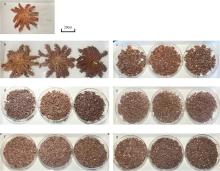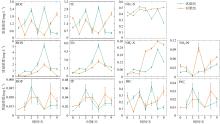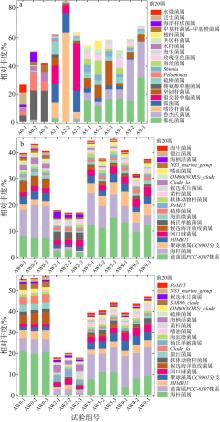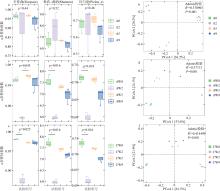热带海洋学报 ›› 2025, Vol. 44 ›› Issue (5): 189-200.doi: 10.11978/2024234CSTR: 32234.14.2024234
长棘海星煮沸灭活残骸的生态环境效应
- 1.自然资源部三沙海洋中心, 海南 三沙 573100
2.海南大学, 海洋生物与水产学院, 海南 海口 570228
-
收稿日期:2024-12-16修回日期:2025-02-20出版日期:2025-09-10发布日期:2025-10-14 -
通讯作者:罗洪添 -
作者简介:刘建根(1993—), 男, 硕士研究生, 主要从事珊瑚礁生态系统保护修复研究。email: 1129590412@qq.com
Ecological and environmental effects of boiled and inactivated remains of crown-of-thorns starfish
LIU Jiangen1( ), LUO Hongtian2(
), LUO Hongtian2( )
)
- 1. The Sansha Ocean Center of the Ministry of Natural Resources, Sansha 573100, China
2. School of Marine Biology and Fisheries, Hainan University, Haikou 570228, China
-
Received:2024-12-16Revised:2025-02-20Online:2025-09-10Published:2025-10-14 -
Contact:LUO Hongtian
摘要: 长棘海星(Acanthaster planci, Crown-of-thorns starfish, CoTS)爆发对珊瑚礁生态系统健康构成了重大威胁。人工清除被认为是解决局部长棘海星爆发最实用和有效的方法之一。目前尚不清楚将捕获的长棘海星灭活后还海对海洋环境的影响。文章通过海区模拟试验评估长棘海星煮沸灭活残骸的生态环境效应。结果表明: 长棘海星煮沸灭活后还海, 在约2d内肌肉组织完全分解, 分解后骨骼呈颗粒状。还海后的第9天, 分别释放了63.20%的碳、62.18%的氮和44.17%的磷到水体中, 使水体碳质量浓度上升(0.08±0.06)mg·L-1、氮质量浓度上升(0.08±0.08)mg·L-1、磷质量浓度下降0.01mg·L-1。此外, 灭活后的长棘海星体表优势菌主要隶属于变形菌门、蓝细菌、放线菌门和拟杆菌门, 其中优势属为拟杆菌门的鞘氨醇单胞菌属(Sphingomonas)和变形菌门的鲁杰氏菌属(Ruegeria)、Pelomonas、那托菌属(Nautella)与坚韧杆菌属(Tenacibaculum), 并与长棘海星分解具有关联作用。长棘海星煮沸灭活残骸分解速度快, 可直接释放营养物质, 灭活后的小量还海对环境没有明显的不利影响, 是一种较为经济-生态友好型的长棘海星爆发处置方式。
中图分类号:
- P764.1
引用本文
刘建根, 罗洪添. 长棘海星煮沸灭活残骸的生态环境效应[J]. 热带海洋学报, 2025, 44(5): 189-200.
LIU Jiangen, LUO Hongtian. Ecological and environmental effects of boiled and inactivated remains of crown-of-thorns starfish[J]. Journal of Tropical Oceanography, 2025, 44(5): 189-200.
| [1] |
康霖, 2016. 西沙群岛海洋渔业资源调查研究[J]. 海洋与渔业 (2): 64-66.
|
|
|
|
| [2] |
李元超, 吴钟解, 梁计林, 等, 2019. 近15年西沙群岛长棘海星爆发周期及爆发原因分析[J]. 科学通报, 64(33): 3478-3484.
|
|
|
|
| [3] |
马清霞, 李宁, 李学刚, 等, 2012. 模拟研究沙海蜇消亡过程中海水pH变化及对海水酸化的影响[J]. 海洋科学, 36(12): 12-18.
|
|
|
|
| [4] |
曲长凤, 宋金明, 李宁, 等, 2016. 海水中沙海蜇消亡对水体碳、氮、磷的释放与补充[J]. 应用生态学报, 27(1): 299-306.
|
|
|
|
| [5] |
宋金明, 李鹏程, 1996. 南沙群岛海域沉积物-海水界面间营养物质的扩散通量[J]. 海洋科学, 20(5): 43-50.
|
|
|
|
| [6] |
夏荣林, 宁志铭, 余克服, 等, 2022. 长棘海星爆发对珊瑚礁区沉积物营养盐动力学的影响研究[J]. 海洋学报, 44(8): 23-30.
|
|
|
|
| [7] |
姚秋翠, 余克服, 廖芝衡, 等, 2022. 棘冠海星爆发及其对珊瑚礁的生态影响研究进展[J]. 生态学报, 42(18): 7517-7528.
|
|
|
|
| [8] |
朱士兵, 胡丹妮, 张会领, 等, 2019. 海口湾中间岸段海滩剖面短期时空变化及沉积动态分析[J]. 热带海洋学报, 38(5): 77-85.
doi: 10.11978/2018120 |
|
|
|
| [9] |
|
| [10] |
|
| [11] |
|
| [12] |
|
| [13] |
|
| [14] |
|
| [15] |
|
| [16] |
|
| [17] |
|
| [18] |
doi: 10.1073/pnas.1015782108 pmid: 21646531 |
| [19] |
doi: 10.1073/pnas.1208909109 pmid: 23027961 |
| [20] |
|
| [21] |
doi: 10.1038/srep28821 pmid: 27353576 |
| [22] |
|
| [23] |
|
| [24] |
|
| [25] |
|
| [26] |
|
| [27] |
|
| [28] |
|
| [29] |
|
| [30] |
|
| [31] |
|
| [32] |
|
| [33] |
|
| [34] |
|
| [35] |
|
| [36] |
|
| [37] |
|
| [38] |
|
| [39] |
|
| [40] |
|
| [41] |
|
| [42] |
doi: 10.1073/pnas.1614778114 pmid: 28630330 |
| [43] |
|
| [44] |
|
| [45] |
|
| [46] |
|
| [47] |
|
| [48] |
|
| [49] |
|
| [50] |
|
| [1] | 姚宇, 刘小娜, 周宝宝, 周婷. 基于XBeach-NH的大糙率礁面波浪运动数值模拟[J]. 热带海洋学报, 2025, 44(5): 31-38. |
| [2] | 冯战权, 苏冒亮, 杜媛媛, 钟友凌, 张俊彬. 基于MaxEnt模型分析全球气候变化对中国沿海带鱼潜在分布的影响[J]. 热带海洋学报, 2025, 44(5): 77-85. |
| [3] | 赵中伟, 赵璇, 陈天然, 李伟. 西沙群岛珊瑚礁2015—2023年间海岸地貌演化与其区域海洋环境特征的关联性研究[J]. 热带海洋学报, 2025, 44(4): 25-44. |
| [4] | 李达, 王云忠, 齐继光, 杨翠华. 水质变化对豆荚软珊瑚(Lobophytum sp.)共生藻(Symbiodiniaceae)、菌群落结构的影响[J]. 热带海洋学报, 2025, 44(4): 136-144. |
| [5] | 何燕春, 徐淑娜, 刘永宏, 杨斌. 北部湾软珊瑚共附生真菌Scopulariopsis sp. SCSIO 41229次级代谢产物研究[J]. 热带海洋学报, 2025, 44(4): 170-176. |
| [6] | 李若安, 李旭清, 陈天然. 南海南部珊瑚骨骼δ18O和Sr/Ca对ENSO的分级响应[J]. 热带海洋学报, 2025, 44(4): 45-55. |
| [7] | 陈裕月, 姜伟, 杨浩丹, 余克服. 近30年来涠洲岛海域海水磷含量变化及其影响因素——来自高分辨率珊瑚记录的证据[J]. 热带海洋学报, 2025, 44(3): 206-216. |
| [8] | 钟丹妮, 姚宇, 周婷. 孤立波作用下三维堡礁地形附近波浪传播变形及爬高研究[J]. 热带海洋学报, 2025, 44(2): 39-47. |
| [9] | 王超, 屈科, 王旭, 高榕泽, 王傲宇. 人工生态礁体群对非平整岛礁孤立波水动力特性影响的试验研究[J]. 热带海洋学报, 2025, 44(2): 30-38. |
| [10] | 何悦铭, 赵立凝, 陈欣琪, 何嘉鸿, 樊浩, 陈乐怡, 张翠仙, 何细新. 海洋本草软珊瑚共附生真菌Aspergillus terreus EGF7-0-1中γ-芳环丁烯内酯类化合物研究(I)[J]. 热带海洋学报, 2025, 44(1): 146-153. |
| [11] | 黄沁愉, 吕丽娜, 李洁, 琚慧敏, 苏宏飞. 珊瑚来源潜在降解对甲氧基肉桂酸辛酯的细菌物种多样性[J]. 热带海洋学报, 2025, 44(1): 133-145. |
| [12] | 邱星宇, 刘庆霞, 陈作志, 蔡研聪, 黄洪辉. 2023年春季南沙珊瑚岛礁主要鱼类碳氮稳定同位素研究[J]. 热带海洋学报, 2024, 43(6): 104-113. |
| [13] | 黄雯, 冯逸, 李明, 武茜, 罗燕秋, 陈胤民, 王丽荣, 余克服. 造礁石珊瑚群体遗传学研究进展[J]. 热带海洋学报, 2024, 43(6): 13-26. |
| [14] | 江柔韵, 简丽丽, 石松标, 田新朋. 美济礁沉积砂可培养细菌多样性分析[J]. 热带海洋学报, 2024, 43(6): 170-180. |
| [15] | 谢宏宇, 刘永, 李纯厚, 赵金发, 孙金辉, 沈建忠, 石娟, 王腾. 西沙群岛浪花礁珊瑚礁鱼类种类组成与演替[J]. 热带海洋学报, 2024, 43(6): 114-128. |
|
||













